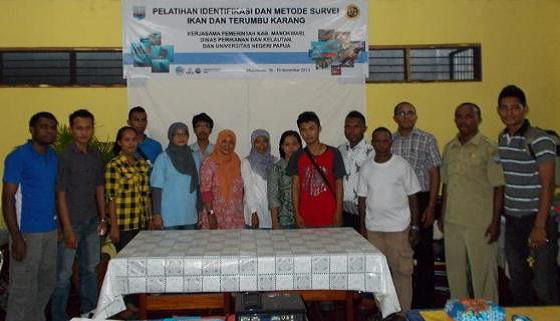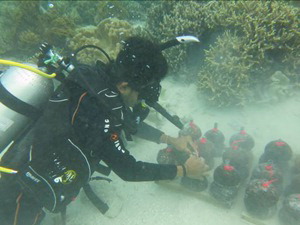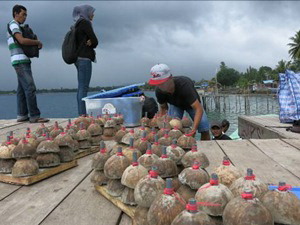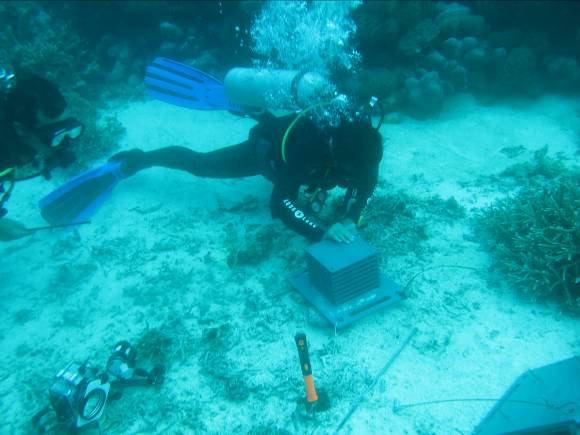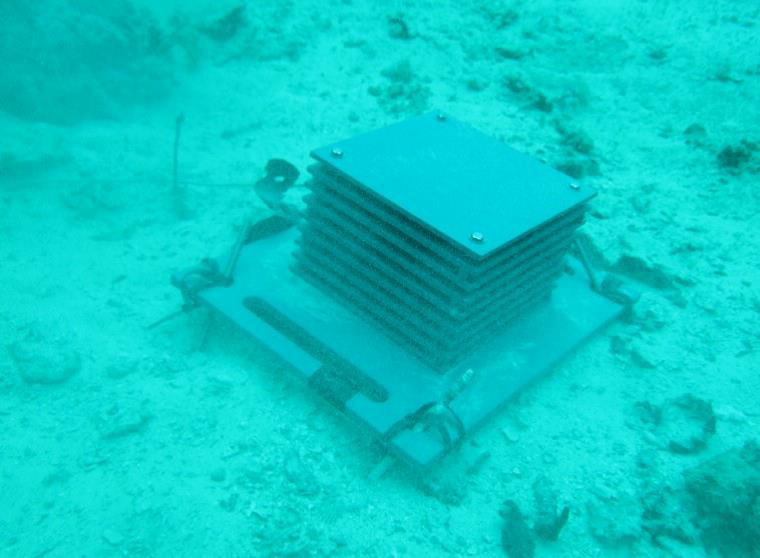Researchers deployed 48 ARMS, collecting more than 200 individuals of 63 invertebrate species and published data on these specimens on their website. The PEER team presented their work at national and international conferences, published regular newsletters to share results, and have published more than 20 academic papers and a book,
Diversity and Conservation of Sea Urchin.
The PI and his colleagues presented a workshop entitled Genetic Analysis and Bioinformatics for the research group on marine resource exploration and management of fisheries and marine sciences of Brawijaya University. They also held several training sessions on genetic data analysis for PhD students from Brawijaya and the State University of Malang, provided training in proposal writing for high school students to apply to the Indonesian Institute of Sciences, and shared their results with all lecturers within the University of Papua.
The PEER project supported students’ thesis research and the PI’s lab hosted undergraduates and fishery students to study laboratory work practices and genetic approaches. Indonesia’s State Ministry of Research and Technology awarded the PEER team an additional research grant to continue their work. The researchers are also part of a consortium that won a new NSF PIRE award to continue collaborative biodiversity research across Indonesia.
The project's monthly newsletter can be found at
www.ibcraja4.org.PublicationsA.H.A. Toha, N. Widodo, B. Subhan, R. Himawan, C. Tania, B.A. Noor, B.S. Stewart, and H.H. Madduppa. 2016. Close genetic relatedness of whale sharks,
Rhincodon typhus, in the Indo-Pacific region.
AACL Bioflux 9(3): 458-564.
http://www.bioflux.com.ro/docs/2016.458-465.pdf D. Saleky, I. Setyobudiandi, A.H.A. Toha, M. Takdir, and H. Madduppa. 2016. Length-weight relationship and population genetic of two marine gastropods species (
Turbinidae: Turbo sparverius and
Turbo bruneus) in the Bird Head’s Seascape Papua, Indonesia.
Biodiversitas 17(1): 208-217.
https://doi.org/10.13057/biodiv/d170130C.J. Starger, M.V. Erdmann, A.H.A. Toha, A.C. Baker, and P.H. Barber. 2015. Strong genetic structure among coral populations within a conservation priority region, the Bird’s Head Seascape (Papua, Indonesia).
Frontiers of Biogeography 7(3): 91-106.
https://doi.org/10.21425/F5FBG22326 A.H.A. Toha, B. Sutiman, Sumitro, Widodo, and L. Hakim. 2015. Color diversity and distribution of Sea Urchin
Tripneustes gratilla in Cenderawasih Bay ecoregion of Papua, Indonesia.
The Egyptian Journal of Aquatic Research 41(3): 273-278.
https://doi.org/10.1016/j.ejar.2015.05.001 D.A. Willette, A.R. Iñiguez, E.K. Kupriyanova, C.J. Starger, T. Varman, A.H. Toha, B.A. Maralit, and P.H. Barber. 2015. Christmas tree worms of Indo-Pacific coral reefs: untangling the
Spirobranchus corniculatus (Grube, 1862) complex.
Coral Reefs 34(3): 899-904.
https://ui.adsabs.harvard.edu/link_gateway/2015CorRe..34..899W/doi:10.1007/s00338-015-1294-y A.H.A. Toha, R. Binur, Suhaemi, Lutfi, L. Hakin, N. Widodo, and S.B. Sumitro. 2014. Genetic aspects of the commercially used sea urchin
Tripneustes gratilla.
Journal of Biological Researches 20(2): 12-17.
P.H. Barber, M.C.A. Ablan-Lagman, Ambariyanto, R.G.S. Berlinck, D. Dahyani, E.D. Crandall, R. Ravago-Gotanco, M.A. Juinio-Meñez, I.G.N. Mahardika, K. Shanker, C.J. Starger, A.H.A. Toha, A.W. Anggoro, and D.A. Willette. 2014. Advancing biodiversity research in developing countries: the need for changing paradigms.
Bulletin of Marine Science 90(1): 187– 210.
https://doi.org/10.5343/bms.2012.1108 A.M. Jackson, Ambariyanto, M.V. Erdmann, A.H.A. Toha, L.A. Stevens, and P.H. Barber. 2014. Phylogeography of commercial tuna and mackerel in the Indonesian Archipelago.
Bulletin of Marine Science 90(1): 471–492.
http://dx.doi.org/10.5343/bms.2012.1097T.S. DeBoer, M.R.A. Naguit, M.V. Erdmann, M.C. Ablan-Lagman, Ambariyanto, K.E. Carpenter, A.H.A. Toha, and P.H. Barber. 2014. Concordant phylogenetic patterns inferred from mitochondrial and microsatellite DNA in the giant clam,
Tridacna crocea.
Bulletin of Marine Science 90(1):301–329.
https://doi.org/10.5343/bms.2013.1002 T.S. DeBoer, M.R.A. Naguit, M.V. Erdmann, M.C. Ablan-Lagman, Ambariyanto, K.E. Carpenter, A.H.A. Toha, and P.H. Barber. 2014. Concordance between phylogeographic and biogeographic boundaries in the Coral Triangle: conservation implications based on comparative analyses of multiple giant clam species.
Bulletin of Marine Science 90(1):277–300.
https://doi.org/10.5343/bms.2013.1003 N. Sahriyani, Widodo, and A.H.A. Toha. 2014. Amplifikasi Gen Coi (Cytochrome C Oxidase Subunit I) pada Holothuroidea yang dikoleksi dari Kepulauan Raja Ampat.
Jurnal Biotropika 2 (4): 232-234.
https://biotropika.ub.ac.id/index.php/biotropika/article/view/297 R.D. Kurniasari, A. Soewondo, and A.H. Toha. 2014. Identifikasi Synaptula (Echinodermata: Holothuroidea) Raja Ampat berdasarkan gen COI.
Jurnal Biotropika 2 (5): 265-268.
https://biotropika.ub.ac.id/index.php/biotropika/article/view/312 F.E. Aprilia, A. Soewondo, Widodo, and A.H.A. Toha. 2014. Amplifikasi Gen COI dan 16s rRNA dari Invertebrata Laut
Plakobranchus ocellatus.
Jurnal Biotropika 2 (5):276-278.
https://biotropika.ub.ac.id/index.php/biotropika/article/view/301 Abdul Hamid A. Toha, Sutiman B. Sumitro, and Luchman Hakim. 2013.
Keanekaragaman dan Konservasi Bulu Babi [Diversity and Conservation of Sea Urchin]. ISBN 978-602-7611-08-5. Available for download at
https://ibcraja4.org/page/read/book_of_seaurchin/
V.B. Silahooy, A.H. Toha, L. Hakim, and N. Widodo. 2013. Spatial distribution of
Tripneustes gratilla on Ambon Island.
The Journal of Tropical Life Science 3(3): 177-181.
https://jtrolis.ub.ac.id/index.php/jtrolis/article/download/122/148 A.H.A. Toha, S.B. Sumitro, L. Hakim, and Widodo. 2012. Kondisi habitat bulu babi
Tripneustes gratilla (Linnaeus, 1758).
Berkala Penelitian Hayati 17(2): 139-145.
https://doi.org/10.23869/205 A.H.A. Toha, A. Permana, S.B. Sumitro, L. Hakim, and Widodo. 2012. Penentuan jenis kelamin bulu babi
Tripneustes gratilla secara morfologi.
Berkala Penelitian Hayati 17(2): 211-215.
https://doi.org/10.23869/224 



